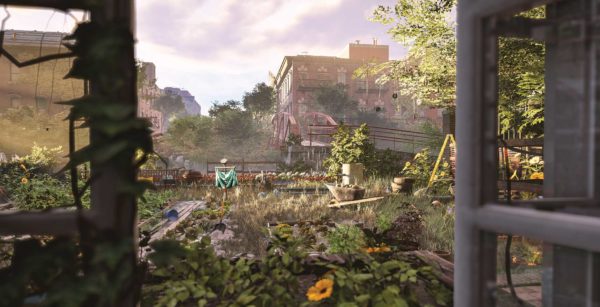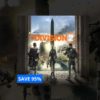An evening spent rebuilding civilisation amongst the dilapidated, gang-infested streets of Washington DC might not sound like the ideal social occasion, but I assure you, that’s all that I want to do right now. Thankfully, that is exactly what The Division 2 offers, an incredible realisation of a nation’s capital in disarray, with communities to liberate and checkpoints to loot. Venturing out into the chaos with your clan mates is near endless fun, with a shiny new bit of gear always tantalisingly within reach, earning its “just one more mission” stripes. Massive Entertainment’s second entry into the ‘looter shooter’ sub-genre is the complete package and, in my mind, sets the new standard.

The Division 2 takes place seven months after the events of the first game, but there’s no expectation for you to be intimately familiar with the predecessor’s story. Most of it is rehashed in dramatic opening cutscenes and bursts of dialogue. Washington DC did not fair any better than New York after the spread of the ‘Green Poison’ virus through banknotes on Black Friday, and with the Division communication network suddenly down, it’s up to you to regain control of the city. I’m convinced the concept is a neat idea, society falls apart and sleeper agents amongst the civilian population are activated in order to restore balance, but unfortunately, much like the last, I struggled to engage with the game’s narrative or connect with any of the characters. A silent protagonist doesn’t help, but the tonal contrast between their fight for survival, and missions reclaiming the Declaration of Independence was also jarring. The Division 2 attempts to create a dark, gritty world, complete with Outlaws armed solely with explosive vests, but it’s hard to take it seriously when the same enemies drive Robo Wars-esque RC cars at you with buzzsaws attached at the front.

Regardless, the story does loosely tie together all the missions and facilitate some fantastic set pieces which are complemented by the top-notch environment design. Whilst the reason behind you completing an objective might be forgettable, the missions are often anything but. Washington DC was a genius choice of setting, not specifically for its political significance, but for the variety of its environments. The city’s museums appear in a couple of notable missions where the exhibits temporarily transport you through time and space, so to speak, and will no doubt distract you
The attention to detail in recreating these environments, and reimagining them in a post-apocalyptic state, is an impressive achievement by Massive and the seven other studios that aided development. With every mission you complete, the impact on the world is increasingly noticeable as Settlements rebuild. The streets feel dangerous and desolate, but the communities lived in. There are elements of environmental storytelling, some more subtle than others, helping capture the events that unfolded, and you are rewarded for exploring off the beaten track. I often found loot, even high tier weapons, hidden down back alleys and secret rooms.

The new setting also offers more open space than returning players will be used to, inviting new approaches to combat. There’s often the opportunity to seek higher ground and defend your position with a sniper. Otherwise, you can bounce from cover to cover, getting the jump on enemies with an SMG, as you may be more accustom to. Either way, the game – complete with eight different skills and a tonne of loadout options – invites some variety to how you might tackle a mission.
Don’t be mistaken though, this is unquestionably a cover-based shooter, and running-and-gunning won’t get you very far. The Division 2 is as every bit challenging as it is rewarding. Loot may be awarded generously, but not without a test first. The enemy AI is some of the best I’ve encountered, constantly flanking you and coordinating attacks. Dealing with an onslaught of aggressive shotgunners or exploding drones can be difficult, whilst infantry flanks you either side and a sniper takes aim from a distance. Enemy types are varied enough to keep you on your toes. The spongey enemies of the first, who seemed to absorb bullets, have been replaced by heavily armoured baddies instead, who fit within the world a little neater. There’s not a great deal of variety when it comes to the bosses and the final mission does feel anticlimactic, but the arenas with which they take place often makes for more enjoyable final battles.

Although the whole game can be experienced solo, and the difficulty scales accordingly, playing with a
The gunplay remains solid and the cover mechanics work brilliantly, even if you do get caught on the occasional bit of rubble. Moreover,

There is a tremendous amount to do between main quests and side missions, Checkpoints and Strongholds, the PvP Dark Zone and Conflicts, all before you complete the core game and hit the level cap. It never feels overwhelming, and beyond the main missions, you are only really expected to sample the other offerings. There’s no real reason to engage with the PvP stuff if you don’t want to, nor any reason to get bogged down ticking every box in each area.
Completing the main game is, however, only just the beginning. Having cleared Washington DC of the enemy factions, a new, tougher threat invades the map in the endgame and breathes new life into the completed Strongholds, Checkpoints and select mission areas. I was pleasantly surprised to see the objectives of these missions changed slightly, making revisiting the same area feel far less repetitive. It may appear to be restarting you, albeit with a more deadly foe, but thankfully there’s more complexity to it than that.

To counteract the increased threat, there are some new gadgets at your disposable. You can select from three different Specialisations, Sharpshooter, Survivalist and Demolitionist, each with their your own skill tree. You can swap between all three anytime back at the base of operations giving you a whole new set of perks to unlock and strategies to master. The world also gains a new progression system where at each stage you will be awarded better and better loot that then upgrades your character’s power level. All in all, it is a generous endgame offering without considering the PvP side of things or the eight-player Raids that are still to come in the free first year of content.






